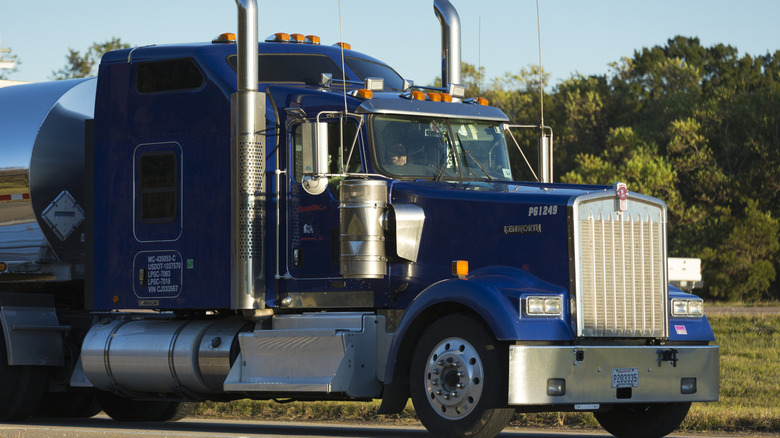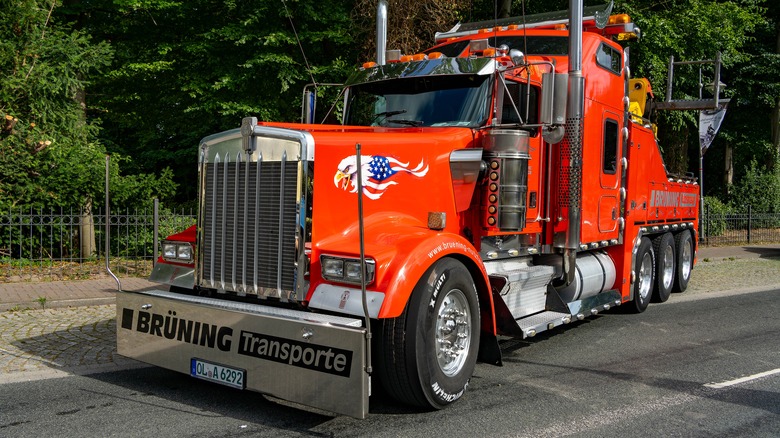What Is The Oldest Kenworth Semi-Truck Still In Production Today?
Founded in 1923 in Seattle, Washington, Kenworth is one of the oldest truck manufacturers in the United States. In its first year, the company began manufacturing its first trucks and produced 78 units straight away. From this modest start, Kenworth has substantially grown by a combination of innovation, adaptation, and a dedication to quality. Today, Kenworth has 14 different models that can be customized for its buyers. One of the most popular Kenworth semi-trucks is the W900, which was first released in 1961, and is still being made today, making it the oldest model in its stable.
The W900 was created as a replacement for the 900 series, it was wider and taller than its predecessor, and sported a redesigned cab with a reworked windscreen for highway use. It also had a longer hood to house bigger engines and larger radiators. An important feature retained from the old model was the tilting hood for easy engine access, which was first introduced in 1959. The W900 name is a combination of its series designation, the 900, with a W added to it, which came from the surname of one of its founders, Edward K. Worthington.
Starting with the original 1961 to 1966 narrow-hood model, the W900 underwent substantial developments to its design. It's successor, the wide-hood model, had a longer production run from 1967 to 1982. In 1976, the W900 received an industry-first update with the addition of the Aerodyne sleeper cab. Next was the W900B, built from 1982 to 2020, which had better electronics and exterior updates. The latest in the series are the W900L, which is still in production, and the W990, a design evolution of the W900.
The W900 is a modern classic semi-truck
Because of its classic style, driver-focused comfort, and reputation for dependability and longevity, the Kenworth W900 continues to be popular within the trucking industry. Kenworth trucks use different engines, and the W900 is renowned for its powerplants, which include the Cummins X15 and the PACCAR MX-13. Both engines have enough horsepower and torque for heavy-haul and long-haul applications. In addition, the sleeper versions of the W900L were equipped with ample audio and video entertainment systems, making downtime more enjoyable for its drivers.
With its lengthy production run, over 280,000 units of the W900 have been made. Its ubiquitous presence can be seen on highways carrying cargo, at construction projects, or logging sites, hauling tons of lumber. However, despite its considerable success, Kenworth recently announced it will end production of the iconic truck. Citing the need for more integrated and efficient technology to comply with more stringent emissions standards as the reason, production of the W900 will finish by 2026. The replacement model for the W900, the more modern-looking W990, is already available
Considered a reliable truck brand, Kenworth maintained its following based on solidly built and driver-focused truck designs. Kenworth also created an electric truck when it released the T680E in 2020, marking its entry into the zero-emission truck market. With a projected operational range of 200 miles, the zero-emission Kenworth T680E is equipped with a 500 kilowatt-hour battery and is charged via a CCS1 DC fast charger, with a 120 kWh maximum rate and a 3.3-hour charging time. By launching its battery-electric and hydrogen fuel cell lines, Kenworth has responded to the industry's need to reduce pollution and move towards more environmentally friendly trucking solutions.

